Baisakh is significant for the Buddhist as the most important of all Buddhist festivals, Buddha Purnima, falls on the full moon day of this lunar month. On this day, Buddhists all over the world commemorate three great events: the Birth, the Enlightenment and the Passing Away of Lord Gautama Buddha. This celebration is not only a festival but it reminds us of Buddha’s teachings of life and his preaching for mankind.
Buddha’s message has captured the hearts and minds of billions of people throughout the world. Buddha was one of the greatest spiritual teachers and Edwin Arnold has fittingly called him the “Light of Asia”.
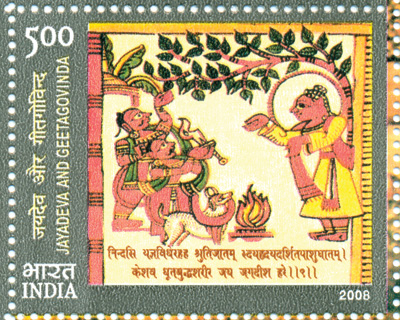 On the occasion of Buddha Purnima and as we observe the Visit Lumbini Year 2012, this article makes an attempt to narrate the story of the Buddha illustrated with postage stamps. A square inch of paper, the humble postage stamp, that most people either hardly ever notice (more so during this age of e-mails) or even discard without a moment’s thought, can tell many stories.
On the occasion of Buddha Purnima and as we observe the Visit Lumbini Year 2012, this article makes an attempt to narrate the story of the Buddha illustrated with postage stamps. A square inch of paper, the humble postage stamp, that most people either hardly ever notice (more so during this age of e-mails) or even discard without a moment’s thought, can tell many stories.
In this article, stamps depicting murals or wall paintings and bas-relief in vihars and thanka painting have been used as illustration. Other stamps show pictures of the most important locations in the life of the Buddha.
 The Beginning
The Beginning
The story of Sakyamuni Buddha can be said to begin in Tushita Heaven, a cosmic realm, pictured on the Mongolian stamp. The 12th century wall painting in Polonnaruva shows the devas’ “plea to the Master to descend from the heaven”. He resided in Tushita after many lifetimes and was waiting for one final lifetime in the mortal world to attain true enlightenment and liberation from the cycle of birth, death and rebirth.
The Dream
More than 2550 years ago, there was a Sakya king named Suddhodana whose capital was in Kapilvastu the ruins of which is shown in the Nepalese stamp. He married a princess named Maha Maya Devi, the daughter of King Anjana of the Koliya tribe.
 One full moon night, the Queen had a vivid dream. The bodhisattva had chosen Queen Maha Maya to be his mother. He appeared to the Queen, descending from heaven in the form of a six-tusked white elephant and entering her sleeping body through her right-side to achieve conception as shown on the stamp of a mural from Gotami Vihar in Colombo.
One full moon night, the Queen had a vivid dream. The bodhisattva had chosen Queen Maha Maya to be his mother. He appeared to the Queen, descending from heaven in the form of a six-tusked white elephant and entering her sleeping body through her right-side to achieve conception as shown on the stamp of a mural from Gotami Vihar in Colombo.
Next day the Queen told the King about the dream. The 18th century painting stamps from Dambava Temple in Matale show King Suddhodana consulting wise men to discover the meaning of the dream. They interpreted her vision as a sign that she had conceived and the child would one day become either a world monarch or a great spiritual leader.
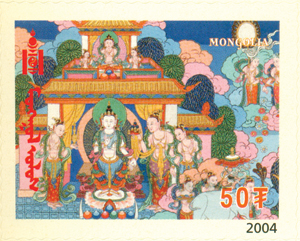 Return to Koliya
Return to Koliya
It was a Sakya tradition at that time for a married woman to return to her parent’s home to deliver her baby. The Queen travelling to Koliya is shown in 5th – 6th century limestone bas-relief from Jetavana Vihar in Anuradhapura. The second stamp is a 18th century paintings from Dambava Temple showing the Queen being carried in a decorated palanquin in a long procession of soldiers, musicians and retainers.
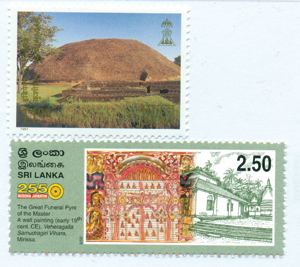 Wondrous Birth
Wondrous Birth
On the way to Koliya, the great procession passed Lumbini park with many trees, flowers and birds. The Queen ordered the bearers to stop for a while for rest.
Shown on the Thai mural is Queen Maha Maya giving birth to Siddhartha while standing beneath a sal tree, her right hand grasping a branch for support. The painting shows Brahma and Indra receiving the newborn.
Siddhartha is said to have emerged from her right side and took seven steps in the four directions. As he walked, lotus flowers bloomed as shown in the Thai stamp. The birth took place on an auspicious full moon day in the lunar month of Baisakh.
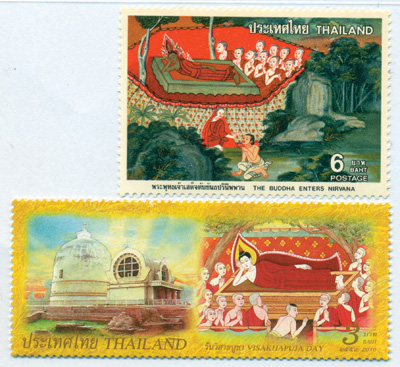 The Queen returned to Kapilvastu and on the fifth day after Siddhartha’s birth, King Suddhodana held a lavish festival.
The Queen returned to Kapilvastu and on the fifth day after Siddhartha’s birth, King Suddhodana held a lavish festival.
The temple painting from Purwarama Vihar in Kataluva shows royal teacher-sage Aista describing the 32 lakshana or major marks of perfection as they appeared on the young prince’s body that indicated that Siddhartha would grow to become a Buddha and teach the path of enlightenment.
Early Life
The Mongolia stamp shows the life in the palace in Kapilvastu where Siddhartha is said to have spent 29 years as a prince. His father ensured that Siddhartha was provided with everything he could want or need. Siddhartha married Princess Yosodhara when he was 16 and a son named Rahula was born.
 Spiritual Awakening – The Four Sights
Spiritual Awakening – The Four Sights
The Japanese painting from 17th – 18th century Edo period issued as stamps by Ghana show the four sights that the Prince saw when traveling outside the palace. Siddhartha saw an old man, a sick man and a dead body. Finally, the fourth sight of a wondering monk who had abandoned the material world impressed and inspired Siddhartha.
Great Departure
So, Prince Siddhartha’s life reached a decisive turning point after the “Four Sights” as they had a profound influence on him and he decided to relinquish the princely life to become an ascetic himself to seek a solution to human suffering.
The murals from Gotami Vihar in Colombo show Siddhartha bidding farewell to his sleeping wife and son and quietly leaving the palace on his horse Kanthaka accompanied by Chandaka. The stamp from Nepal shows the ruins of the “great renunciation gate in Kapilvastu.
When he reached a forest near Anoma River, Siddhartha dismounted from his horse. The stamp of rock carving from Borobodur in Indonesia shows Siddhartha cutting his hair with a sword, a symbolic confirmation of his transition to a wandering ascetic.
Siddhartha sent Chandaka back to Kapilvastu and from that day on he wore the humble yellow robe of an ascetic. This Great Renunciation is depicted 5th – 6th century bas-relief from Girihandu Vihara in Ambalantota.
 The Search
The Search
Siddhartha travelled to Rajagriha where Magadha King Bimbisara offered him half the kingdom. Siddhartha declined but agreed to return after he had attained enlightenment.
Siddhatha together with five other ascetics namely Kaundinya,Vaspa, Bhadrika, Mahanaman and Asvajit, practiced a harsh regimen of meditation for six years and this is depicted in a stone statue from Gandhara on the stamps from Pakistan. His sun-baked body is reduced to skin and bones with deep hollows under the eyes and brought Siddhartha near death from starvation.
At that point Siddhartha realized that the most effective approach to life is to avoid the extremes but instead follow the Middle Path of moderation, which is the corner stone of his teachings.
 Abandoning his five friends he reached Niranjana River where he accepted an offering of rice-milk offered by a young woman named Sujata as shown in the mural painting from Samudragiri Vihar.
Abandoning his five friends he reached Niranjana River where he accepted an offering of rice-milk offered by a young woman named Sujata as shown in the mural painting from Samudragiri Vihar.
Siddhartha crossed the river where a farmer gave him a bundle of kusa grass which he spread beneath a pipal tree and sat down to meditate.
A 19th century painting in Hindagala Vihar shows Mara, the personification of evil, leading an army to destroy Siddhartha’s concentration.
Next Siddhartha touches the ground with his right hand as shown in the 14th century bronze Buddha statue from Thailand on Gambian stamp, in bhumisparsa mudra, to beckon the Earth Goddess as his witness.
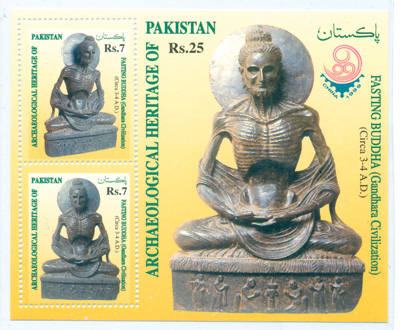 This 19th century richly detailed painting from Thailand, the Buddha Subduing Mara, on the Grenada stamp, has three parts. On the right Mara’s army is attacking Siddhartha. In the center of the stamp, the Earth Goddess wrings her long black hair to unleash a flood that sweeps away Mara and his army. On left side of the stamp is the final scene where Mara is swept away.
This 19th century richly detailed painting from Thailand, the Buddha Subduing Mara, on the Grenada stamp, has three parts. On the right Mara’s army is attacking Siddhartha. In the center of the stamp, the Earth Goddess wrings her long black hair to unleash a flood that sweeps away Mara and his army. On left side of the stamp is the final scene where Mara is swept away.
Siddhartha practiced meditation under the Bodhi Tree and he achieved Enlightenment and became Lord Buddha. He gained complete comprehension of the endless cycle of birth, death and rebirth. This auspicious event took place on the full moon day in Baisakh at Bodhgaya and the Sri Maha Bodhi Temple is shown on the stamps from India and China.
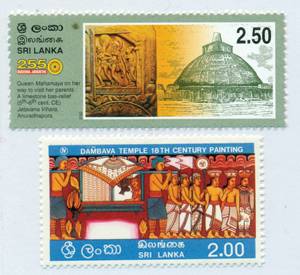 Seven Stations of Enlightenment
Seven Stations of Enlightenment
The Buddha remained in the precincts of Bodhgaya for seven weeks continuing his meditation. Four of the seven stamps from Laos show this period of meditation: Buddha experiencing the sublime joy of his perfect liberation, he then stood gazing at the tree in gratitude, and he is protected from rain by naga raja Muchalinda.
The temple mural from Samudragiri Vihar shows two merchants named Tapussa and Bhallika who appeared at the end of the seventh week and presented Buddha with a bowl of rice and honey.
First Turning of the Wheel
The Buddha travelled to Sarnath to look for his five monk friends whom he had left earlier. The Dhammekka Stupa at Sarnath where is met them is shown on the Thai stamp.
Buddha preached The Four Noble Truths to the five disciples one of whom, Konthunya Brahmin, was the first to archive enlightenment and was ordained the first Buddhist monk. This was also the place of communion for sixty disciples of Lord Buddha.
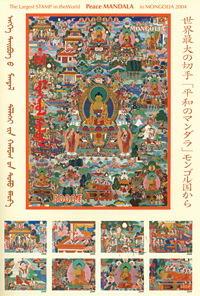 Miracle and Some Parables
Miracle and Some Parables
For next forty-five years the Buddha and his disciples travelled to different places to disseminate the words of Lord Buddha and initiate new followers to the Dharma.
On one occasion he applied his supernatural powers to ascend into Tauatimsa Heaven to visit his mother Queen Maha Maya who had passed away when he was just seven days old. He stayed there for three-month rainy season preaching Dharma to her. On the Thai stamp the Buddha is shown descending from the triple staircase created by the gods.
Dhammapada is one of the best-known books of the Pitaka. It is a collection of the teachings of the Buddha. Four important stories from the Dhammapada are pictured in the Sri Lankan stamps.
The first stamp is Verse 180 related to the Brahmin and his wife who lived in the kingdom of the Kurus with their exceedingly beautiful daughter Magandiyā and offered her to the Buddha in marriage.
The second stamp refers to Verse 114 about the story of Kisa Gotami who goes in search for some mustard seeds from a house where there had been no death.
The third stamp shows Verse 113 which is about Patacara, the daughter of a rich man from Savatthi to whom Buddha expounded the Anamatagga Sutta.
The final fourth stamp relates to Angulimala mentioned in Verse 173 who had killed 999 persons before he encountered Buddha and changed is ways.
Mahaparinirvana
Buddha continued his teaching of the Dharma into his eightieth year. After being seriously ill he paused to rest in a sal tree grove in Kushinara. As shown on the Thai stamp he lay down on his right side between two sal trees, his head facing north. Buddha then announced that he would enter parinirvana. The death of the Buddha took place on the full moon day of Baisakh (as did his birth and awakening).
The Shrine as shown on the Thai stamp is the place where Lord Buddha entered the state of parinirvana. A mahaparinnirvana vihar building is located at the front, sharing the same base as the shrine. Inside is a Buddha statute in the attitude of entering parinnirvana.
The Indian stamp shows the Ramabhar Stupa in Kushinagar that marks the actual cremation site of the Buddha. The wall painting from Samudragiri Vihar in Mirissa shows the cremation pyre of the Buddha.
Accounts of the Buddha’s death include the story of how his cremated remains were divided into portions and distributed throughout northern India. The wall painting at Kelaniya Temple is of Princess Hemamali and her husband, Prince Dantha, bringing the tooth relic to Sri Lanka. The second stamp shows the picture of Dalada Maligawa, the Temple of Sacred Tooth, in Kandy including the inner sanctorum where the holy tooth relic is worshipped.
Some Hindu traditions like in Gita Govinda, the 13th century influential poet Jayadev Goswami, portrays Buddha as the most recent ninth of the Dasavatar of Vishnu.
To End
Buddhism motif is found on postage stamps from nearly 110 countries and territories in the world. Of course traditionally Buddhist countries have issued many Buddhism related stamps. Then from Bamiyan Buddha in Afghanistan to Borobudur in Indonesia appear on stamps. The far away Pacific island of Nauru has issued stamps with picture of the Buddha from Po Lin Monastery in Hong Kong. Surinam in South America has issued stamps related to Buddhism including our own Swayambhunath stupa.
Even Russia has issued four stamps related to Buddhism including Gedden Sheddup Choikorling Monastary at Kalmykia republic, the region in Europe where the state religion is Buddhism. There are stamps related to many aspects of Buddhism like auspicious symbols, various hand mudras, places of significance, festivals, religious dances, important personalities, etc.









